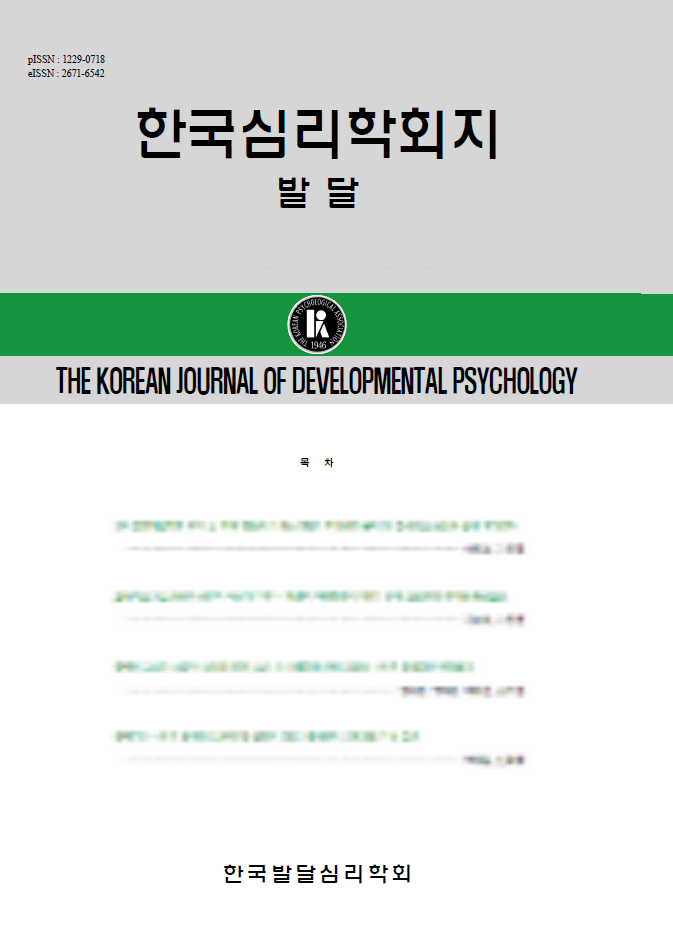open access
메뉴
open access
메뉴 ISSN : 1229-0718
ISSN : 1229-0718

본 연구는 만 10개월 영아들이 상대방의 목표 행동 이해에 언어적 단서를 활용할 수 있는 지를 기대위반 패러다임을 통해 알아보았다. 만 10개월 영아들은 친숙화 시행에서 행위자가 무의미 단어가 포함된 문장(“모디가 있네!”)을 두 번 발화한 후 무대 위 두 물체 중 하나의 물체를 잡는 동작을 네 시행(짧은 친숙화 조건)또는 여섯 시행(긴 친숙화 조건)동안 관찰하였다. 검사 전 진열 시행에서는 두 물체의 위치를 바꾼 정지 장면이 제시되었다. 검사 시행에서 영아들은 행위자가 새로운 무의미 단어가 있는 문장(“파푸가 있네!”)을 두 번 발화한 뒤 친숙화 시행 때 잡았던 물체(기존 목표 사건) 또는 한 번도 잡지 않았던 물체(새 목표 사건)를 잡는 동작을 관찰하였다. 검사 시행의 응시시간 분석 결과 짧은 친숙화 조건의 만 10개월 영아들은 기존 목표 사건을 새 목표 사건보다 더 오랫동안 응시한 반면, 긴 친숙화 조건의 영아들은 기존 목표 사건과 새 목표 사건을 비슷하게 바라보았다. 본 연구 결과는 목표 행동 이해에 있어서 언어정보를 활용하는 능력이 만 10개월 전후에 발달함을 보여주면서, 언어발달과 사회 인지 발달과의 관련성에 대해서 함의점을 제공한다.
In the current research we used the violation-of-expectation paradigm to examine whether 10-month-olds use linguistic cues when understanding others’ goals. During four (short-familiarization condition) or six (long-familiarization condition) familiarization trials, 10-month-olds heard a female agent saying “Here’s a modi!” twice and saw her grasping one of two objects. The locations of the two objects were switched during the pre-display trial. During test trials, infants heard a different linguistic cue (“Here’s a papu!”), and saw the actor reach for either the same object as before (the old-goal event) or the other object (the new-goal event). Ten-month-olds looked longer at the new-goal event than at the old-goal event in the short-familiarization condition, whereas they looked about equally at the two events in the long-familiarization condition. These results demonstrate 10-month-olds’ understanding that an agent’s novel verbal information may signal a change in her upcoming actions.
Baillargeon, R. (1994). How do infants learn about the physical world? Current Directions in Psychological Science, 3, 133-140.
Balaban, M. T., & Waxman, S. R. (1997). Do words facilitate categorization in 9-month-old infants? Journal of Experimental Child Psychology, 64, 3-26.
Buresh, J. S., & Woodward, A. L. (2007). Infants track action goals within and across agents. Cognition, 104, 287-314.
Cohen, R. L. (1985). On the generality of the laws of memory. In L.-G. Nilsson & T. Archer (Eds.), Perspectives on learning and memory. Hillsdale, NJ: Erlbaum.
Cooper, E. H., & Pantle, A. J. (1967). The total-time hypothesis in verbal learning. Psychological Bulletin, 68, 221-234.
Dewar, K., & Xu, F. (2007). Do 9-month-old infants expect distinct words to refer to kinds? Developmental Psychology, 43, 1227-1238.
Graham, S. A., Stock, H., & Henderson, A. M. E.(2006). Nineteen-month olds’ understanding of the conventionality of object labels versus desires. Infancy, 9(3), 341-350.
Guajardo, J. J., & Woodward, A., L. (2004). Is agency skin-deep? Surface attributes influence infants' sensitivity to goal-directed action. Infancy, 6, 361-384.
Henderson A. M. E., & Woodward, A. (2012). Nine-month old infants generalize object labels, but not object preferences across individuals. Developmental Science, 15, 641-652.
Jin, K., & Song, H. (in preparation). The role of verbal information in reasoning about others:actions in infancy.
Jovanovic, B., Király, I., Elsner, B., Gergely, G.,Prinz, W., & Aschersleben, G. (2007). The role of effects for infants’ perception of action goals. Psychologia, 50(4), 273-290.
Kim, E. Y., & Song, H. (2015). Six-month olds actively predict others’ goal-directed actions. Cognitive Development, 33, 1-13.
Martin, A., Onishi, K. H., & Voulumanos, A.(2012). Understanding the abstract role of speech in communication at 12 months. Cognition, 123, 50-60.
Liittschwager, J. C., & Markman, E. M. (1994). Sixteen- and 24-month-olds’ use of mutual exclusivity as a default assumption in secondlabel learning. Developmental Psychology, 30, 955-968.
Luo, Y. (2011). Do 10-month-old infants understand others’ false beliefs? Cognition, 121, 289-298.
Luo, Y., & Baillargeon, R. (2005). Can a selfpropelled box have a goal? Psychological reasoning in 5-month-old infants. Psychological Science, 16, 601-608.
Phillips, A. T., Wellman, H. M., & Spelke, E. S.(2002). Infants’ ability to connect gaze and emotional expression to intentional action. Cognition, 85, 53-78.
Song, H., Baillargeon, R., & Fisher, C. (2005). Can infants attribute to an agent a disposition to perform a particular action? Cognition, 98, B45-B55.
Song, H., Baillargeon, R., & Fisher, C. (2007). Can 9.5-month-old infants attribute to an agent a disposition to perform a particular action on objects? Acta Psychologica, 124, 79-105.
Song, H. -j., Baillargeon, R., & Fisher, C. (2014). The development of infants' use of novel verbal information when reasoning about others' actions. PLoS ONE, 9(3), e92387.
Spaepen, E. U., & Spelke, E. S. (2007). Will any doll do? Twelve-month-olds’ reasoning about goal objects. Cognitive Psychology, 54, 133-154.
Woodward, A. L. (1998). Infants selectively encode the goal object of an agent’s reach. Cognition, 69, 1-34.
Wynn, K. (1992). Addition and subtraction by human infants. Nature, 358, 749-750.
Xu, F. (2002). The role of language in acquiring object kind concepts in infancy. Cognition, 85(3), 223-250.
Xu, F., Cote, M., Baker, A. (2005). Labeling guides object individuation in 12-month-old infants. Psychological Science, 16, 372-377.
